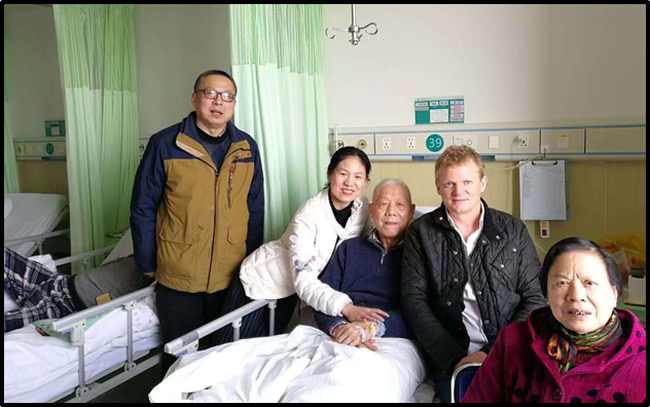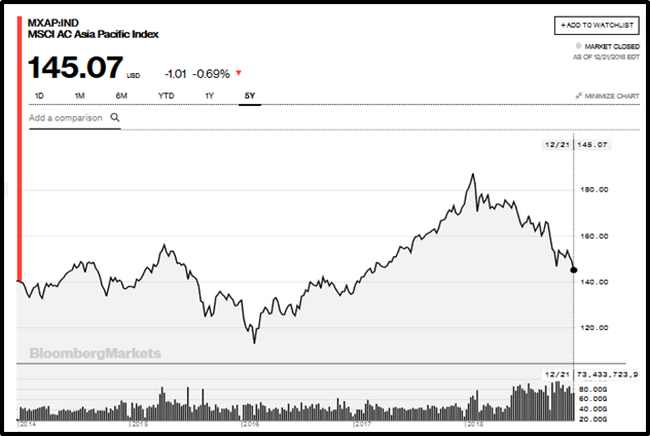by Guy Bennett
Christmas Eve, 2018 – I’m writing this from a hospital bed in a hard scrabble town in the mountains of Yunnan Province, China, called Yong Shan. It’s an industrial feeder town for a hydro-electric dam where my Chinese wife works.
In this article, I’ll give you a street-level view of the Chinese hospital system – and explain why the Chinese healthcare system is the mother of all investment opportunities – and what the barriers are.
But first, I’ll tell you how I got here.
Last night, I woke up at 2 a.m. – could not breathe – my skin was sweaty and cold. Using my clumsy Mandarin, I told the desk clerk that I needed a hospital. He scrawled a map on a napkin and I lurched wheezing into the dusty street.
At the hospital they immediately gave me an ECG. They also X-rayed my lungs. And applied a lung-blasting vaporizer.
By a weird coincidence, my Chinese Father-In-Law is in the same hospital waiting to have his gall bladder removed. Here we are two days ago – from left to right: my brother-in-law, my wife, my father-in law, me and my mother-in-law.
Western media outlets love the “China’s-Health-Care-System-is-Broken” narrative (line-ups, violence, kick-backs to surgeons etc).
“While the wealthy have access to the best care in top hospitals with foreign doctors, most Chinese people are relegated to overcrowded hospitals,” states The New York Times, “The country does not have a functioning primary care system.”
Over the years, I’ve been in 8 different Chinese hospitals – in villages, 3rd tier cities, and Beijing. From my perspective, the system isn’t broken – it’s straining.
China has one GP for every 6,600 people, compared with the recommended standard of one for every 1,500 to 2,000 people, by the World Health Organization.
My brother-in-law in the above photo is a trial judge. He’s been off work for 7 days, looking after his father, including helping with toiletry functions, and washing his father’s body. He has a cot that he lays at the foot of his father’s bed. He sleeps there all night, every night.
Functions that are performed by Practical Nurses in the west, are not offered in public Chinese hospitals. If you don’t have a family member to help you go to the washroom, you hire a stranger (there’s a gaggle of them in hospital lobby looking for work). It’s considered shameful but the demand is there.
145 million Chinese residents are now over the age of 65 – about 10% of the population. According to the United Nations that number will double by 2038.
The per-capita health expenditure in China is about $1,000 – compared to $6,500 in Canada and to $13,000 in the U.S. There’s room to grow.
China has published a blueprint “Healthy China 2030” to establish an integrated healthcare and system which encourages “private investment and foreign capital participation in the healthcare sector.”
The ad hoc system of hiring day-labourers to wash your parents’ bodies, is going to be replaced by a model closer to standard western elder-care.
Chinese adult children with money, will place their parents in private hospitals and clinics with a nursing staff capable of providing secondary care.
By 2030, the size of China’s healthcare market is expected to reach $3.3 trillion.
Multi-nationals like Merck, Johnson & Johnson, Sanofi, and GlaxoSmithKline (GSK) are now financing start-ups to address health problems in China.
The Chinese healthcare sector carries big opportunities and big risks.
Networks of private clinics in China sometimes mushroom and then blow up – through lack of government oversight. This summer, the whole Chinese healthcare sector got pounded when Changchun Changsheng Bio-tech was charged with fabricating production and inspection data on a rabies vaccine.
MSCI China Health Care contains large and mid cap representation across China H shares, B shares, Red chips and P chips and Large Cap A shares.
The Shanghai exchange (down 20%) and Shenzhen exchange (down 30%) have been dismal this year. Chinese stocks among the worst performers globally. By comparison the S&P 500 is down 6%, Japan’s Nikkei 225 is down 9% and the German DAX has lost some 16%.
You can purchase Chinese stocks through a broker that operates on Chinese exchanges, or buy ETF products that allow you to purchase a basket of Chinese stocks.
The MSCI fund is a good way for foreigners to purchase “A-shares” in the health sector. Normally these are only available to residents of China or foreign employees of A-share companies.
MSCI is volatile, it lost about 4% in 2015, 2016, it gained 58% in 2017, lost 16% in 2018. It does have a solid 5-year compound growth rate of 8% – but like most index funds, it’s not going to turn into an 8-bagger in 2019 – though I anticipate it will kick the shit out of the S&P 500.
In 2018’s dying days, gaining access to the Chinese healthcare sector – from North America – takes some ingenuity.
C-Bridge Capital is a $1 billion healthcare private equity firm, focused on Chinese pharmaceuticals, medical devices, diagnostics, and healthcare services.
Based in Shanghai, the fund invests in cutting edge technologies that fulfil unmet medical needs and improve the standard and quality of care for Chinese patients.
“C-Bridge invests in a concentrated portfolio of companies with validated science and near-term commercialized products,” states the CEO, “we take a hands-on approach to add value, ensuring that the companies are ready for the next phase of growth.”
The company has about 55 PHD’s in a room, figuring shit out.
Unless you understand what this means: “a humanized immunoglobulin G1 (IgG1) targeting granulocyte-macrophage colony-stimulating factor (GM-CSF)” – that’s what you need.
To get in on the next round of financing at C-Bridge contact Sean Cao, Managing Director at sean.cao@cbridgecap.com.
With each procedure at the Yong Shan hospital, I had to keep going back to the cashier and bucking up. When the nurse took my temperature, she demanded a 5 Yuan ($1) deposit to make sure I did not steal the thermometer.
If it sounds like I’m making fun, I’m not. I was alarmed (you don’t realise how sweet life is until it appears to be slipping away). They tested me, charged me almost nothing ($85) and acted like pros. I’ve got medication for my lungs, and I’m already feeling better.
In 1960, the average life expectancy in China was 44. By 1980, it increased to 65. It’s now 76. Now there are simply too many people for the socialised medical system to handle.
As non-government money flows into the Chinese healthcare sector to fill that gap – fortunes will be made.
I’d like to invest in a Chinese elder-care pure play.
But there’s currently no way for a foreigner to do it.
When that changes, I’ll be there with my cheque-book.
And I’ll tell you about it too.
Christmas blessings from China.




Glad you are feeling better Lukas. As much as we enjoy reading your articles, we can survive a few weeks without one. Take a break, enjoy the holidays – you’re a work horse…
P.S. Chris, hang on to this guy
firewiz, so kind and unexpected. I have the constitution of a Viking, and am quickly on the rebound. No need to take a long break. The Chinese don’t celebrate Christmas. I mean, they try, but the heart is not in it. Thank you for generous comment, it is registered and deeply appreciated.